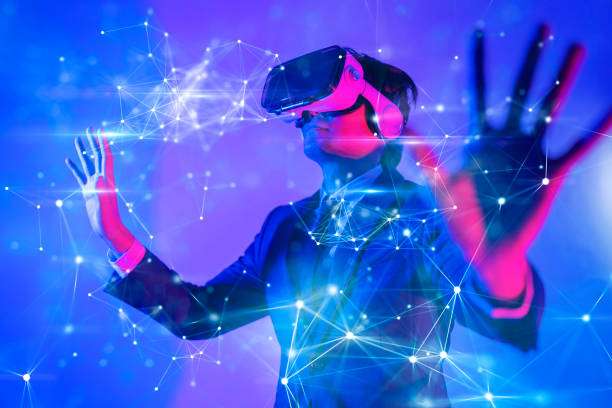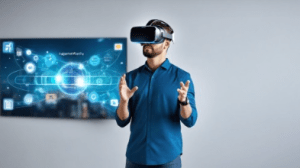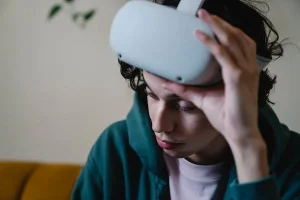
Augmented reality (AR) and virtual reality (VR) are two groundbreaking technologies that have huge impacts on our daily individual or business lives as it is completely changing the method of human interactions.
Although both augmented reality and virtual reality have not flourished yet like AI tools such as Chat GPT, Bing, Bard, and many others, these two terms became the major attraction for modern youths and tech-savvy people. Both augmented reality and virtual reality offer immersive, playful, and real experiences.
Although both augmented reality and virtual reality might seem like similar technology at first glance, they are completely different from each other.
If you are also new to these two technologies – augmented reality and virtual reality, and are not fully aware of them, this article is a must for you. After reading this article fully, you will come to know the below-mentioned topics.
Click this link to learn more ways to earn money
augmented reality means integrating digital elements such as audio, text, visuals, graphics, and other stimuli into the real-world environment in real-time.
In other words, let’s say, AR overlaps the computer-generated elements into our physical environment to provide interactive experiences to the users in real-time. It enriches the user’s experience by blending virtually produced elements into the real surroundings.
It could be experienced through devices made to experience augmented reality like headsets, and tablets. It can also be experienced through smartphone cameras.
VR is a type of technology that builds so immersive and simulated surroundings which can replace the real world. By wearing VR headsets, users are taken to the digital era where users can interact virtually with any person or object in the world, in the way they are interacting in the real world.
It is very crucial to become fully aware of the basic differences between these two technologies – augmented reality and virtual reality. For your convenience, we’ve made a table to differentiate augmented reality and virtual reality
This table summarizes the key differences between AR and VR, showcasing their unique characteristics and potential applications. It is important to note that both technologies offer unique possibilities for the future, and the decision to choose one over the other should depend on the specific purpose and desired experience.
| Feature | Augmented Reality (AR) | Virtual Reality (VR) |
|---|---|---|
| Immersion Level | It enhances the real world by integrating digital elements | It creates a completely immersive virtual environment |
| Interactions | It maintains full interaction with real-world | It has limited or no interaction with real-world |
| Hardware | Smartphones, tablets, AR glasses | Specialized VR headsets |
| Examples | Navigation apps, virtual furniture placement, game overlays | Gaming, simulations, virtual experiences |
| Focus | It brings digital information to reality | It replaces reality with a simulated environment |
| Benefits | It provides real-time information and enriches real-world experiences | It offers immersive, interactive virtual experiences, and seamless engagement |
| Challenges | There may be some Privacy concerns regarding real-world data collection, limited interaction with virtual content, and technical limitations. | There might be sensory overload, disconnect from the real world, high hardware costs, and potential health risks |
There are some similarities between AR and VR that you must know if you want to be an expert in the subject and the concept is very important, especially for professionals.
These are some similarities between augmented reality and virtual reality:
1. Immersive Experiences:
– Both AR and VR aim to provide immersive experiences to users, transporting them to a digital environment (VR) or enhancing their real-world surroundings (AR).
2. Digital Interaction:
– Both technologies involve interaction with digital elements. In VR, users interact entirely within a simulated environment, while AR overlays digital information onto the real world for interaction.
3. Technological Integration:
– AR and VR rely on advanced technologies, including sensors, cameras, and displays, to create realistic and interactive experiences.
4. Application Diversity:
– They find applications across various industries, including gaming, education, healthcare, architecture, and marketing, showcasing their versatility.
5. Enhanced Visualization:
– Both technologies focus on enhancing visualization—AR by adding digital information to the real world and VR by creating entirely new visual environments.
6. Evolutionary Roots:
– The historical development of AR and VR involves shared milestones in the exploration of immersive technologies, even though they diverged in functionality over time.

Augmented reality and virtual reality have had their presence for several decades, but they didn’t flourish until previous years when they gained such huge attention. The same applies to Ai as well, which flourished in a greater way only after the publishment of Chat GPT. Google Glass was the first widely used AR device released by Google.
The first VR headset was released in the 1960s just for military and industrial purposes, but it wasn’t commercially available for consumers in the market until the 1990s.
However, early VR systems were bulky, expensive, and limited adoption by specialized industries. Then in the 20th century, VR systems became more accessible than ever before with the introduction of affordable headsets and graphical elements.
Over the years, both AR and VR technologies have evolved significantly. AR and VR are becoming more important topics across several industries from healthcare, and science to even gaming. Improvements in technology have made them more accessible and immersive.

2. Google Maps AR Navigation:
– AR overlays arrows and directions on the real-world view through your phone’s camera to guide you during navigation.
3. IKEA Place:
– Allows users to preview how furniture will look in their homes by superimposing virtual IKEA products onto their actual living spaces.
4. Snapchat Filters:
– Snapchat uses AR to add entertaining filters, masks, and effects to users’ faces in real time.
5. Augmented Reality in Medical Training:
– Medical professionals use AR for training simulations, such as practicing surgeries on virtual patients.
Virtual Reality (VR) Examples:
1. Oculus Rift:
– A VR headset used for immersive gaming experiences, providing users with a 360-degree view of virtual environments.
2. Virtual Reality in Education:
– VR applications for educational purposes, allowing students to take virtual field trips or explore historical events.
3. Medical VR Simulations:
– Virtual reality simulations are used for medical training, allowing practitioners to practice surgeries in a realistic environment.
4. Google Earth VR:
– Users can explore the world in a virtual environment, flying over cities and landmarks in a 3D experience.
5. VR in Architecture Walkthroughs:
– Architects use VR to provide clients with immersive virtual walkthroughs of architectural designs before construction.
These examples showcase the diverse applications of AR and VR across gaming, navigation, retail, healthcare, education, and more.

Augmented Reality and Virtual Reality have found vast and diverse applications in a wide range of industries which include education, healthcare, design, military, etc. They are transforming the way we work, learn, and experience the world by bringing so many uses. Below are some of the major industries where augmented reality and virtual reality are being used.
In the gaming and entertainment industry, VR has revolutionized gaming experiences by creating immersive worlds and enabling players to control the motion by themselves. It helps to engage with virtual environments in ways never seen before.
Virtual reality gaming has boosted the gaming experiences of youths and children to new heights. It allows players to step into virtual worlds and interact with their surroundings, making it more realistic.
Players can dive into the world of games, they always wanted to play and go into. Augmented reality has also made its mark in the gaming industry, with the most popular games like Pokémon Go.
Integrating AR into these games helps captivate millions of players worldwide. These technologies can make virtual elements so unique and interactive that users forget what is reality and what is fantasy. This is the power of Augmented Reality and Virtual Reality
Additionally, Augmented Reality and Virtual Reality have been embraced by the education and training sector as well.
These modern technologies help students to visualize the most complex concepts and topics through which students can easily remember the topics and their related information during their examination period and also for the longer term. It is not easy that visually read information from anyone’s mind.
Students can easily explore historical sites, examine virtual organisms, or travel through space, and planets all from the comfort of their classrooms and homes with the use of VR. Just imagine, how amazing it would look.
It also provides professionals with the opportunity of realistic simulations which they can use for practicing the activity for their skill development.
Remember without taking any risk, without damaging physical infrastructures, and without harming any people or animals, surgeon students can practice complex procedures virtually, they can learn to do the operation of frogs. Just kidding!
Remember, pilots can even simulate flight scenarios which might reduce their cost and accidents, and military personnel can undergo realistic training simulations, learn how to use guns and missiles, can learn to fight without harming their peers. Just think about it. It is wonderful.
In the field of healthcare and medicine, AR and VR technologies have the potential to revolutionize patient care, medical training, and research.
In healthcare and medicine, both Augmented Reality and Virtual Reality have proven to be the most valuable tools. It helps in providing training to medical professionals, improving patient outcomes, and also assisting in surgical procedures. VR is also used for managing the patient’s pain and dealing with their phobias.
Practitioners can do their tests and trials virtually without any animals or humans which reduces the risk of errors and improves surgical outcomes when applied practically in real life.
Medical students can learn about the human body and internal organs in a more informative way, and trainees or interns can learn to do surgeries virtually without taking the risks of any humans.
Moreover, they have made significant impacts in the architectural and design industry. Augmented Reality and Virtual Reality technologies enable architects to visualize their creations in 3D, adjusting and rebuilding them according to the consumer’s needs and preferences.
This allows customers to experience virtual walkthroughs of their future homes before their construction of home begins. Hence, all architects, designers, and house owners can make informed and better decisions with their style, materials, looks, and colors.
They can identify problems upfront that might occur after the completion of the building, thus they can solve these issues easily and refine their designs with the help of AR and VR.

Augmented Reality and virtual reality have so many outstanding advantages that normal people like us cannot even think up to that level. All the benefits that these technologies offer are far beyond our thoughts, they won’t be caught in our thoughts.
Some industries might benefit more while some industries might benefit less, but every individual, business, and industry can use these modern, flourishing, unimaginable technologies to enhance their life, revenue, and overall business by reducing effort, minimizing cost, and enhancing effectiveness.
Students can have a better understanding and better information retention rate if they use augmented Reality and virtual reality in their classrooms or education. They can get an immersive and enjoyable experience so that they won’t be bored longer anymore while studying.
Similarly, in the healthcare sector, augmented reality and virtual reality can help to enrich the effectiveness of medical or surgical training and offer nonrisky treatments and experiments.
Additionally, augmented reality and virtual reality have huge potential to revolutionize the marketing field by creating engaging and interactive ads and social campaigns that have huge potential to get the customer’s attention eventually leading them to try the product or services once.
Furthermore, augmented reality and virtual reality can help boost productivity in every individual workplace by improving communication, bridging gaps, reducing human errors, and streamlining the work processes.

Although augmented Reality and virtual reality have numerous opportunities, applications, and revolutionary power, they have a lot of challenges and difficulties that need to be considered. One of the main challenges is their cost which is very high for normal consumers like us.
We cannot afford it easily because it costs more to bring solutions for developing and implementing them into real life. Along with its cost, other problems such as hardware, and their sizes also bring uncomfortability. This limits the adoption of these amazing technologies.
Another serious challenge it carries is health-related issues. Wearing VR headsets and prolonged use of screens could result in motion sickness, disorientation, eye problems, and headaches.
Children and even youths can be addicted to this, so it needs to be friendly and playful but not addictive. Also, some ethical things should be taken into consideration while using augmented Reality and virtual reality.

I think the future of AR and VR is filled with exciting possibilities. Isn’t it?
Let us know by your comments on what you think about augmented reality and virtual reality In the upcoming years or decades. What changes it could bring? How does it help in your daily life? Or, what could be its major challenge?
The advancement of 5G networks plays a huge role in the flourishment of Augmented Reality and virtual reality technology as they need faster, more reliable, and seamless connections to work properly. And this can be achieved only with the help of 5G networks.
Moreover, improvements in machine learning and artificial intelligence led to the development of augmented Reality and virtual reality as AI helps to provide more realistic simulations and provide close interactions in digital environments, just like real surroundings, but with better quality.
Similarly, the integration of other advanced technologies and software such as haptic feedback and eye-tracking will further help in providing a real experience to the users and enhance the level of user immersion.
Augmented reality and virtual reality have transformed the way we perceive and interact with the world. These immersive technologies have found applications in gaming, education, healthcare, architecture, marketing, and various other industries.
While there are challenges and limitations to overcome, the benefits and potential of AR and VR are undeniable.
As technology continues to advance, we can expect AR and VR to become more accessible, affordable, and integrated into our daily lives. The future holds exciting possibilities, from more realistic virtual experiences to AI-powered intelligent augmented reality.
With each new development, AR and VR will continue to shape and redefine our reality, opening up endless opportunities for innovation and exploration.
So, whether you’re a gamer seeking thrilling adventures, a student looking for immersive learning experiences, or a business aiming to create engaging marketing campaigns, augmented reality and virtual reality are here to stay and revolutionize the way we perceive and interact with the world.
1. What is the difference between Augmented Reality (AR) and Virtual Reality (VR)?
– AR enhances the real world with digital elements, while VR creates a fully immersive virtual environment.
2. Where are Augmented Reality and Virtual Reality making a significant impact?
– Both technologies are transforming gaming, education, healthcare, architecture, marketing, and more.
3. How did Augmented Reality and Virtual Reality evolve?
– It evolved back from the 1990s and mid-20th century, with significant advancements in hardware, graphics, and accessibility.
4. What advantages do Augmented Reality and Virtual Reality offer?
– Enhanced user experiences, improved learning, increased efficiency, and expanded market opportunities.
5. What challenges do Augmented Reality and Virtual Reality face?
– Technical limitations, cost factors, user comfort concerns, and ethical issues, including privacy considerations.
6. What future trends can we expect in Augmented Reality and Virtual Reality?
– Anticipate advances in hardware, integration with artificial intelligence, smart glasses for AR, and VR’s expansion beyond gaming.
7. How can I stay updated on Augmented Reality and Virtual Reality trends?
– Subscribe to our newsletter for the latest insights, expert opinions, and news on the evolving world of AR and VR. Subscribe now to stay informed!
If you want to stay up to date with the latest trends and advancements in augmented reality, virtual reality, and other technologies be sure to subscribe to our newsletter. Whether you’re a technology enthusiast or a professional in the field, our newsletter will provide you with valuable insights, expert opinions, and exciting news about AR and VR.
If you are interested in new and modern technology, please check our new article on